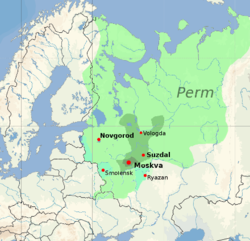- 28 Jun 2023 20:56
#15278407
Accurate 100 %. While Putin hallucinates about Muscovy’s ”historic territories”, he is free to lead by example and move Muscovites away from the Finno-Ugric historic territories.
Historical facts can help to understand why Russia is "knocked out" by the direction of development from the rest of the Slavic countries. Almost all Russian cities of Central Russia, which have more than 500 years of history, have Finno-Ugric names. And this is much more serious for research than the names of the rivers, since it means that the population with the corresponding language lived in these cities. A simple study of the map of Central Russia will help to understand this fact. For example, the city of Ryazan was the tribal center of the ethnographic group of the Mordovians - Erzi, and was first called Erzyan. The city of Kolomna has a number of hypotheses about the origin of its name, however, all of them, translated from the Finno-Ugric languages, mean: "fish river", "border river", etc. The city of Murom comes from the name of the Finno-Ugric tribe Muroma and means "people on land". The city of Vologda, according to the generally accepted hypothesis, comes from the Finno-Ugric (Vep) word for "white", "light". The name of the Volga River comes from the same word. The city of Suzdal, mentioned for the first time in 1024, obviously comes from the Finno-Ugric word for "virgin". The city of Kostroma, like the neighboring Tolshma, Totma, Vokhroma, also comes from the Finno-Ugric languages, in which the last syllable "ma" means "land" (an interesting parallel is the modern Estonian island of Saarema). The city of Tver in ancient times was called Tikhver, which is translated from the Vepsian language as "quiet, thick water." There is still a river and lake Tikhvera nearby, as well as the city of Tikhvin. The city of Kizhi is translated from the Karelian language as "games". The city of Klyazma is translated from the Mordvi-Erzi language as "to crawl wide". The city of Mozhaisk is translated from the same language as "a shallow place". The city of Valdai is translated from the northern Finno-Ugric dialects as "light, white." The city of Simbirsk until the 17th century was called Sinbirsk, which is translated from Mordovian as "green mountains". The city of Kargopol is translated from the Karelian language as "bear side". Regarding the name of the Russian capital, the most popular are hypotheses that derive the name of Moscow by analogy with other Finno-Hungarian names - Protva, Kushva, Lisva, Sosva, Neva, Kolva, Silva. The Russian historian Klyuchevsky claimed: "At one Kama, one can count 20 tributaries that had such an ending. "Va" in Finnish means water." True, in Russia there are several Slavic names of quite old cities - Yaroslavl, founded in the Zalesskaya wilderness by the Great Kiev Prince Yaroslav the Wise, and Vladimir, founded in the same wilderness to collect tribute by the Grand Duke of Kiev Vladimir Monomakh.
Historical facts can help to understand why Russia is "knocked out" by the direction of development from the rest of the Slavic countries. Almost all Russian cities of Central Russia, which have more than 500 years of history, have Finno-Ugric names. And this is much more serious for research than the names of the rivers, since it means that the population with the corresponding language lived in these cities. A simple study of the map of Central Russia will help to understand this fact. For example, the city of Ryazan was the tribal center of the ethnographic group of the Mordovians - Erzi, and was first called Erzyan. The city of Kolomna has a number of hypotheses about the origin of its name, however, all of them, translated from the Finno-Ugric languages, mean: "fish river", "border river", etc. The city of Murom comes from the name of the Finno-Ugric tribe Muroma and means "people on land". The city of Vologda, according to the generally accepted hypothesis, comes from the Finno-Ugric (Vep) word for "white", "light". The name of the Volga River comes from the same word. The city of Suzdal, mentioned for the first time in 1024, obviously comes from the Finno-Ugric word for "virgin". The city of Kostroma, like the neighboring Tolshma, Totma, Vokhroma, also comes from the Finno-Ugric languages, in which the last syllable "ma" means "land" (an interesting parallel is the modern Estonian island of Saarema). The city of Tver in ancient times was called Tikhver, which is translated from the Vepsian language as "quiet, thick water." There is still a river and lake Tikhvera nearby, as well as the city of Tikhvin. The city of Kizhi is translated from the Karelian language as "games". The city of Klyazma is translated from the Mordvi-Erzi language as "to crawl wide". The city of Mozhaisk is translated from the same language as "a shallow place". The city of Valdai is translated from the northern Finno-Ugric dialects as "light, white." The city of Simbirsk until the 17th century was called Sinbirsk, which is translated from Mordovian as "green mountains". The city of Kargopol is translated from the Karelian language as "bear side". Regarding the name of the Russian capital, the most popular are hypotheses that derive the name of Moscow by analogy with other Finno-Hungarian names - Protva, Kushva, Lisva, Sosva, Neva, Kolva, Silva. The Russian historian Klyuchevsky claimed: "At one Kama, one can count 20 tributaries that had such an ending. "Va" in Finnish means water." True, in Russia there are several Slavic names of quite old cities - Yaroslavl, founded in the Zalesskaya wilderness by the Great Kiev Prince Yaroslav the Wise, and Vladimir, founded in the same wilderness to collect tribute by the Grand Duke of Kiev Vladimir Monomakh.








 - By Tainari88
- By Tainari88 - By Rancid
- By Rancid - By Rich
- By Rich